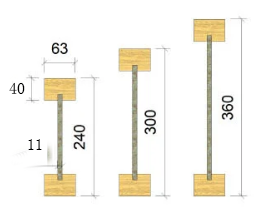Plywood is a cornerstone of the modern construction industry, a truly versatile building material that builders, architects, and DIY enthusiasts have relied on for decades. But what makes plywood so special, and why does it continue to be a preferred choice in countless construction projects? This article dives deep into the world of plywood in construction, exploring its myriad advantages, diverse applications, and the critical role it plays. If you're involved in construction or simply curious about this remarkable engineered wood product, you'll discover why plywood isn't just a sheet of wood, but a key to efficient, durable, and innovative building. We'll explore everything from how plywood is made to its impact on the future of plywood in building.
What Exactly is Plywood and How is Plywood Made?
At its heart, plywood is an engineered wood product. But how do we make plywood? The manufacturing process is quite ingenious. It involves taking thin layers of wood veneer – these are thin slices of timber, often from softwood like pine or fir, or hardwoods like birch plywood. These veneer sheets are then carefully glued together. The magic happens in the orientation: each layer's grain is typically rotated 90 degrees to the adjacent layer. This cross-graining technique is what gives plywood its remarkable strength and stability.
The layers, often called plies, are bonded under high heat and pressure using a strong adhesive. The number of plies can vary, usually an odd number (3, 5, 7, etc.), which helps to balance the board and prevent warping. The type of adhesive used also plays a crucial role in determining the plywood's properties, such as its resistance to moisture or its suitability for interior or exterior use. This careful layering and bonding process results in large, flat plywood sheets that are stronger and more resistant to shrinking, swelling, and warp than solid wood of similar dimensions. It's a testament to how engineering can enhance natural timber for better performance in construction.
Why is Plywood a Go-To Building Material in the Construction Industry?
Plywood has truly carved its niche as a staple building material in the construction industry, and for very good reasons. One of the primary advantages of plywood is its exceptional strength-to-weight ratio. This high strength means it can withstand significant loads, making it ideal for various structural applications without adding excessive weight to the structure. This makes handling easier on site and can reduce the overall load on a building's foundation. The cross-laminated structure of plywood distributes stress over a larger area, reducing the likelihood of splitting when nailed or screwed near the edges – a common issue with solid wood.
Furthermore, plywood offers remarkable dimensional stability. Unlike solid wood, which can expand, contract, or warp significantly with changes in humidity and temperature, plywood maintains its shape and size much more consistently. This stability is crucial for ensuring tight fits and maintaining structural integrity over time. Its versatility is another key factor; plywood can be easily cut, drilled, and shaped, making it adaptable to a wide array of construction designs and needs. From subflooring and wall sheathing to roofing and cabinetry, plywood provides a reliable and workable solution. The construction sector values plywood for its ability to speed up construction time due to its availability in large sheet sizes.
What Are the Different Types of Plywood Used in Construction Projects?
Not all plywood is created equal, and understanding the different types of plywood is essential for selecting the right material for your construction project. One major category is Structural Plywood. This type of plywood is designed and tested to meet specific strength and performance standards, making it suitable for load-bearing applications like beams, flooring, and wall bracing. When you see grades like F11 or F17, these refer to the plywood's stress grade, indicating its capacity for structural applications.

Then there's Marine Plywood, which is a higher quality plywood made with waterproof glue (typically a phenolic adhesive) and from durable veneer species. Despite its name, it's not entirely waterproof but is highly resistant to moisture, making it ideal for boat building, docks, and bathroom or kitchen subflooring where conditions can be damp. Interior plywood is designed for use in dry, indoor environments and often uses urea-formaldehyde glue, which is less water-resistant. It's commonly used for furniture, cabinetry, and interior paneling. For concrete work, shuttering plywood or Formply F17 1800x1200x17mm is the go-to. This plywood often has a film face to provide a smooth finish to the concrete construction and allow for multiple reuses. There are also specialized grades of plywood like fire-retardant plywood and flexible plywood for curved surfaces.
How Does Plywood Compare to Other Engineered Wood Products like OSB?
In the realm of engineered wood panels, plywood often finds itself compared to Oriented Strand Board (OSB). Both are widely used in construction for similar applications like subflooring, wall sheathing, and roof decking, but they have distinct differences in their composition and performance. Plywood is made from thin layers of wood veneer glued together, while OSB is made from rectangular wood strands or flakes arranged in cross-oriented layers and bonded with waterproof, heat-cured adhesives. This difference in how they make plywood versus OSB leads to varied characteristics.
Generally, plywood is considered to have better resistance to moisture over long periods, especially at the edges. If a sheet of OSB gets wet, its edges can swell more significantly and may not return to their original dimensions as well as plywood might. However, advancements in OSB manufacturing have greatly improved its moisture performance. Plywood also tends to be stiffer than OSB of the same thickness. On the other hand, OSB often boasts more consistent density throughout the panel and can be more cost-effective. When choosing plywood or OSB, the specific application, budget, and local building codes often dictate the best choice. For instance, some builders prefer plywood for subfloors due to its perceived stiffness and better nail-holding power, while OSB is a very popular choice for wall and roof sheathing due to its cost-effectiveness and consistent panel quality.
What Key Advantages Does Plywood Offer for Structural Applications?
When it comes to structural applications in construction, plywood brings a host of compelling advantages of using it. Its high strength-to-weight ratio is paramount. The cross-laminated structure of veneer layers distributes loads effectively, making plywood exceptionally strong in both along-grain and across-grain directions. This bi-directional strength is crucial for elements like shear walls and diaphragms, which need to withstand lateral forces from wind or seismic activity. This inherent strength of plywood makes it a reliable choice for building frames that need to stand the test of time.
Another significant advantage is plywood's impact resistance. It can absorb shocks and impacts without fracturing as easily as some other materials, which is beneficial for floors and walls that might experience rough use. The ability to withstand shear forces is also superior in plywood. This means it resists the forces that try to make the layers slide past each other, which is critical for maintaining structural integrity in beams and gusset plates. Furthermore, plywood sheets provide excellent nail and screw holding power. The layers of wood provide a solid grip for fasteners, ensuring secure connections, which is vital for the overall stability of any construction. For these reasons, structural plywood remains a preferred choice for structural applications.

Can Plywood Withstand Harsh Environmental Conditions?
Plywood's ability to withstand harsh environmental conditions largely depends on the plywood type and how it's treated. Standard interior plywood, made with urea-formaldehyde glue, is not designed for outdoor use or areas with high humidity, as it can delaminate or warp when exposed to moisture. However, exterior-grade plywood and especially marine plywood are manufactured using waterproof adhesives, like phenol-formaldehyde, which provide excellent resistance to moisture. This makes them suitable for applications where the plywood will be exposed to rain, humidity, or even direct contact with water.
Even with moisture-resistant types, it's important to note that plywood is still a wood product. Prolonged exposure to water without adequate protection (like sealants or paints) can eventually lead to swelling, decay, or mold growth, though marine grade plywood is available and designed to resist these issues much better. For truly demanding environments, pressure-treated plywood is available, where chemical preservatives are forced into the wood structure to protect against rot, fungal decay, and insect infestation. Choosing plywood with the appropriate grade and treatment for the expected environmental exposure is key to ensuring its durability and long-term performance in any construction project. Many suppliers offer specialized products like marine plywood for these very applications.
What is the Role of Plywood in Modern Formwork and Concrete Construction?
Plywood plays an indispensable role in modern formwork and concrete construction. Formwork is the temporary or permanent mold into which concrete is poured and shaped. The quality of the formwork directly impacts the finish and dimensional accuracy of the hardened concrete. Plywood, particularly shuttering plywood and film-faced plywood, is a highly favored material for this purpose. Its large panel sizes help in creating large, seamless concrete surfaces, reducing the number of joints and finishing work required. This can significantly speed up the construction time and improve overall efficiency.
Film-faced plywood is especially popular because it has a smooth, resin-impregnated paper overlay on both sides. This film provides a very smooth surface, resulting in a high-quality finish on the concrete. It also increases the plywood's resistance to moisture, abrasion, and chemicals present in concrete, allowing for multiple reuses of the formwork panels. This reusability makes plywood a cost-effective option for large construction projects. The strength of plywood allows it to withstand the hydrostatic pressure of wet concrete without bulging or breaking, ensuring that the final concrete structure meets the design specifications. As a factory specializing in engineered wood products, we often supply Phenolic film faced plywood 16mm for such demanding applications, highlighting its importance as a construction staple in concrete construction.

How Do You Ensure You're Choosing High-Quality Plywood for Your Construction Needs?
Choosing plywood of high-quality is critical to the success and longevity of any construction project. As Mark Thompson, a seasoned company owner, would attest, quality inspection is paramount. First, check the grades of plywood. These grades (e.g., A, B, C, D for face veneers, or structural grades like F-ratings) indicate the quality of the veneer and the presence of defects like knots or voids. For structural applications, always ensure the plywood meets the specified structural grade and relevant building codes. Look for certification marks from recognized bodies; for instance, products compliant with standards like the Forest Stewardship Council (FSC) indicate sustainable sourcing.
Visually inspect the plywood sheets. The surface should be relatively smooth, and the edges should be uniform without significant voids or delamination between the layers of wood. The thickness should be consistent across the sheet. Inquire about the adhesive used, especially if the plywood will be exposed to moisture; exterior-grade or marine plywood should use waterproof glues. Moisture content is another key factor; plywood with excessively high moisture content can warp or encourage mold. Reputable plywood manufacturers will provide information on these aspects. For B2B buyers like Mark, establishing a relationship with reliable suppliers who can provide consistent quality plywood and transparent documentation, including certifications and test reports, is crucial. This helps avoid the pain point of inconsistent quality from batch to batch.
What is the Environmental Impact of Plywood Production and Use?
The environmental impact of plywood is a multifaceted topic. On the positive side, plywood is made from wood, a renewable resource. When sourced from sustainably managed forests (e.g., those certified by the Forest Stewardship Council), plywood production can be more environmentally friendly than materials like steel or concrete, which are more energy-intensive to produce. Wood also sequesters carbon, meaning it stores carbon dioxide from the atmosphere, which can help mitigate climate change. The manufacturing process for plywood is also generally less energy-intensive compared to many other construction materials.
However, there are environmental considerations. The type of adhesive used in plywood can be a concern. Some adhesives, particularly older urea-formaldehyde formulations, can off-gas volatile organic compounds (VOCs), including formaldehyde, which can impact indoor air quality. Modern plywood manufacturers are increasingly using low-VOC or no-added-formaldehyde (NAF) adhesives to address this issue. Deforestation is another concern if the timber is not sourced responsibly. Therefore, choosing plywood from suppliers who prioritize sustainable forestry practices and use eco-friendly adhesives is important for minimizing the environmental impact of plywood. The plywood industry is continuously working on improving its construction practices to be more sustainable. Plywood can also contribute to energy efficiency in buildings by providing good insulation, potentially reducing heating and cooling costs.
What is the Future of Plywood in the Evolving Construction Industry?
The future of plywood in the construction industry looks bright and continues to evolve. While new construction materials emerge, plywood remains a reliable choice due to its unique combination of strength, versatility, and cost-effectiveness. Innovations in plywood manufacturing are leading to even better products. For example, there's ongoing research into more durable and environmentally friendly adhesives, as well as treatments to enhance plywood's resistance to fire, moisture, and pests. Engineered plywood products, sometimes combined with other materials, are being developed for specialized high-performance applications.

As sustainability becomes an even more critical factor in building practices, plywood sourced from certified forests is well-positioned to meet the demand for green building materials. The plywood industry is also exploring ways to use a wider variety of timber species and to optimize veneer usage, further enhancing its sustainability profile. We're also seeing plywood used in innovative architectural designs, showcasing its aesthetic potential beyond just functional applications. From prefabricated components to custom designs, plywood is often a key material in construction. Its ability to be precisely cut and shaped using CNC technology also opens up new possibilities for complex geometries. Plywood stands as a testament to how a traditional material in construction can adapt and continue shaping the future of construction. Investing in quality plywood from trusted sources like us, who offer a range of products including OSB Board 12mm and Non Structural Plywood, ensures that your construction project benefits from these advancements. Although plywood has been around plywood for a long time, its journey is far from over.
Key Takeaways:
- Plywood is an engineered wood product made by gluing together thin layers of wood veneer with alternating grain directions, providing excellent strength and stability.
- It is a versatile building material used in various construction applications, from structural plywood for framing and flooring to shuttering plywood for concrete construction.
- Key advantages of plywood include its high strength-to-weight ratio, dimensional stability, impact resistance, and ease of workability.
- Different types of plywood, such as marine plywood, interior plywood, and structural plywood, cater to specific construction needs and environmental conditions.
- When choosing plywood, consider its grade, the adhesive used, moisture content, and certifications to ensure high-quality materials for your project.
- The environmental impact of plywood can be positive when sourced from sustainable forests and manufactured with low-VOC adhesives.
- The future of plywood in the construction industry remains strong, with ongoing innovations enhancing its performance and sustainability.
This comprehensive look at plywood in construction should help you appreciate its value and make informed decisions for your next construction project.
Post time: May-09-2025




